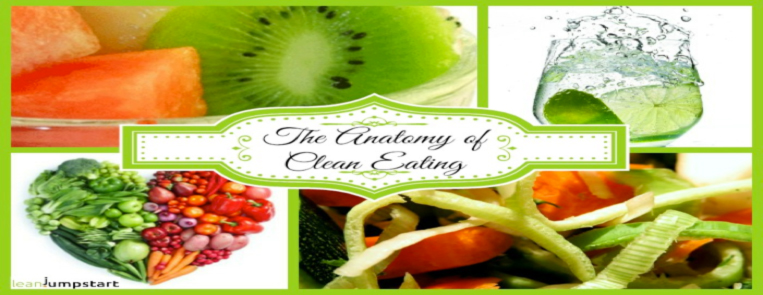 There’s been a lot of talk about ‘clean eating’—and hopefully this movement is here to stay. Talk about ‘clean’ foods began to crop up in the mid-1990’s; this was right when people began to question their food products, ingredients and sources, and health foods stores started popping up and gaining more customers.
There’s been a lot of talk about ‘clean eating’—and hopefully this movement is here to stay. Talk about ‘clean’ foods began to crop up in the mid-1990’s; this was right when people began to question their food products, ingredients and sources, and health foods stores started popping up and gaining more customers.
Can’t Read it, Don’t Eat it!
Flip over your box of cereal or premade dessert and try to read the ingredient list—if it’s filled with crazy 12-letter words that you can’t even imagine how to pronounce, don’t buy it. These are toxic chemicals and preservatives or just fillers harmful to YOU. You should be able to read and recognize the ingredient list on your foods. This makes it simple for you to make a choice—and don’t worry, it’s not as limiting as you may think. Clean eating doesn’t mean you have to cut out some of your favorite snacks or treats, just look for it in a different form. Opt for an ice cream made with real, whole ingredients or a pick a box of crackers made from organic brown rice.
THE FEWER INGREDIENTS THE BETTER.
Choose the Whole Food More often than not, choose foods in their most natural state. This should be the vast majority of your diet. It’s OK to treat yourself once in a while, but most of the foods we eat shouldn’t come from a box (even if you can read the ingredients)—unless that box lists one ingredient and one ingredient only (like brown rice or quinoa). Grab an apple instead of applesauce, eat bran instead of a bran muffin, nibble on some snap peas instead of the dehydrated, salty kind.
Go Organic sometimes.
I am not sold on buying everything organic. Try to follow the “Clean 15, Dirty Dozen” rule. Produce with a rind, tough skin or a barrier of some sort, like onions, avocados, banana, pineapple, cantaloupe, sweet potatoes and grapefruit… IF YOU PEEL AND TOSS THE SKIN can be bought conventionally; just be sure to wash them thoroughly with 1 part vinegar and 3 parts water. Soft-skinned fruits and vegetables like berries, apples, celery, peppers, potatoes and lettuces should always be purchased organic.
The Dirty Dozen.
The Environmental Working Group (EWG) gets the credit for naming the “Dirty Dozen.” This nonprofit group discovered which fruits and vegetables contain the highest—and lowest—pesticide levels through diligent research involving over 100,000 pesticide reports from the USDA and the FDA. These pesticide levels are tested after the produce has been “power” washed by the USDA.
The infamous Dirty Dozen are:
| Celery Peaches Strawberries Apples |
Blueberries Nectarines Bell peppers Cherries |
Potatoes Grapes Lettuce Spinach, kale and collard greens |
The EWG thinks the soft skin of these tasty fruits and veggies allows them to absorb more pesticides than other fruits and veggies. Their recommendation is to always buy organic when it comes to the Dirty Dozen.
The Clean 15
Thankfully the EWG also has a list of non-organic produce that contain little to no pesticides! Notice that many of these foods have a rind, tough skin or some sort of barrier—blocking out some of the pesticide absorption.
Here are the Clean 15:
| Onions Avocados Sweet corn Pineapple |
Mango Sweet peas Asparagus Kiwi fruit |
Cabbage Eggplant Cantaloupe Watermelon |
Grapefruit Sweet potatoes Sweet onions |
If you want to be completely safe and can afford it, buy all of your produce organic. For many people, that just might not be realistic, so instead, commit to buying organic for the Dirty Dozen and thoroughly washing your produce.
Washing Produce
Okay, even though the Dirty Dozen’s pesticide levels were measured after being washed by the USDA, you should always wash all of your produce again once you’re at home. Research does not clearly show how much pesticide residue can be removed by washing—but it can eliminate surface pesticides. Also, you can wash away the germs and bacteria you picked up from the grocery cart, shopping belt or your shopping bags, and protect yourself from foodborne illness.
For a simple, all natural way to wash your produce, you’ll need white vinegar, water and a spray bottle or bowl. For hard-skinned fruits and veggies (like the Clean 15), pour equal parts of vinegar and water into a spray bottle; spray the produce, rub it in and then rinse. For soft-skinned produce (like the Dirty Dozen), mix equal parts vinegar and water in a bowl; soak the fruits and veggies for one to two minutes and rinse. If you’d rather purchase a produce wash, look for all-organic produce wash from your local health food store.
DIY Chef As much as you can
Create meals and snacks yourself. Make trail mix by mixing different nuts and some dried fruits (even better: dry the fruit yourself!), mix up your own salad dressing (this one is super important, many dressings are chemical nightmares) or make your own chicken “nuggets” with slices of chicken breast, almond meal and coconut oil. The Internet is a vast treasure-trove of awesome recipes filled with whole foods.
Support the Right Sources.
Clean eating also has an ethical twist to it. Supporting companies and farmers who work hard to produce pesticide-free foods and products can have a sort of ripple effect, positively influencing the planet and our food supply. It also means buying meats that have been treated humanely and supporting companies that don’t overfish or disrupt ecosystems. There’s also an emphasis on decreasing your carbon footprint; for example, choose local whenever possible.